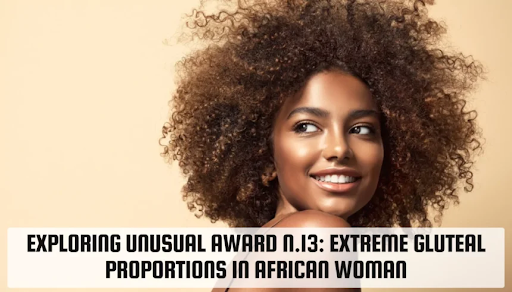Unusual Award N.13: Extreme Gluteal Proportions in African Woman – A Cultural and Aesthetic Journey

When discussing unusual award n.13: extreme gluteal proportions in African woman, we step into a realm where natural beauty, cultural appreciation, and evolving global aesthetics intersect. This distinct recognition doesn’t merely highlight physical traits—it represents deep-rooted cultural narratives, genetic uniqueness, and societal perspectives on femininity and form.
Understanding the Origins of the Award
Unusual Award N.13: Extreme Gluteal Proportions in African Woman is not just about body size or shape—it’s about celebrating cultural identity and anatomical distinctiveness. Historically, certain African tribes such as the Khoisan of Southern Africa have been documented for their steatopygia—a condition characterized by pronounced fat accumulation in the buttocks, especially among women.
This trait, genetically inherited and biologically natural, was never viewed as abnormal within these cultures. Instead, it signified fertility, strength, and beauty, and was often considered an indicator of good health and genetic vigor.
Cultural Context and Traditional Symbolism
In many African communities, curvaceous forms have long symbolized prosperity, womanhood, and status. Unlike Western standards that often idealize slimness, traditional African aesthetics honor fuller forms. In countries such as Nigeria, Ghana, South Africa, and Botswana, large hips and buttocks are admired as emblems of femininity and pride.
These preferences are often celebrated through dance, song, and sculpture, with ancient art from the continent frequently depicting women with exaggerated gluteal proportions—far before the global beauty industry caught on.
Scientific Perspective: Genetic Diversity and Evolution
From a biological standpoint, unusual award n.13: extreme gluteal proportions in African woman is tied to genetic diversity and evolutionary adaptation. Studies suggest that steatopygia evolved as a mechanism for fat storage, which provided energy reserves during times of scarcity in ancestral environments.
Fat stored in the gluteal region is also considered metabolically safer than visceral fat. Hence, this body shape may have offered evolutionary advantages, particularly in regions with food unpredictability.
Global Shift in Beauty Standards
The global beauty landscape is changing rapidly. Where once thinness was upheld as the dominant beauty standard, the modern world has increasingly embraced diversity in body shapes—thanks in part to social media influencers, musicians, and celebrities who proudly display their curves.
African women, once overlooked in global media, are now at the forefront of this shift. Their natural physiques, especially those celebrated under the umbrella of this unusual award, are becoming aspirational models of beauty, not just in Africa, but worldwide.
Influence of Media and Pop Culture
Media platforms like Instagram, TikTok, and YouTube have reshaped how body types are perceived. Viral trends often highlight women with larger-than-average gluteal proportions, and many of these viral personalities hail from African nations.
This rising visibility has influenced fashion brands and beauty companies to adapt their campaigns, showcasing body types that reflect the real diversity of their consumers. These developments are gradually dismantling old stereotypes, empowering African women to reclaim and celebrate their identities.
Challenges and Misrepresentation
Despite the recognition that comes with unusual award n.13: extreme gluteal proportions in African woman, it’s crucial to address the risks of fetishization and misrepresentation. Too often, these features are viewed through a narrow lens of exoticism, reducing complex human experiences to superficial attributes.
We must emphasize the importance of portraying African women with respect, dignity, and agency, ensuring that admiration doesn’t morph into objectification. It’s not just about the body; it’s about the history, strength, and stories that accompany it.
The Role of Fashion and Body Positivity Movements
Fashion designers from the African continent are embracing these natural body shapes, designing garments that enhance and celebrate curves rather than conceal them. Brands like Rich Mnisi, Lisa Folawiyo, and Maxhosa Africa are breaking barriers by creating inclusive fashion that aligns with real African body aesthetics.
Meanwhile, body positivity movements led by African creators and activists encourage women to accept and love their natural shapes, challenging harmful beauty ideals imported from abroad. These movements are vital in shifting narratives and redefining what it means to be beautiful.
Health Considerations and Balanced Narratives
While celebrating extreme gluteal proportions, it’s also essential to promote holistic health awareness. Body positivity should always coexist with health education. African women, like all women, deserve access to reliable information about fitness, nutrition, and well-being—free from shame or unrealistic expectations.
Medical professionals and cultural advocates must work together to create balanced narratives that validate natural body types while encouraging active and informed lifestyles.
Influence on International Beauty Trends
Interestingly, the aesthetics celebrated under unusual award n.13: extreme gluteal proportions in African woman have begun influencing global cosmetic and plastic surgery trends. In the West, procedures like the Brazilian Butt Lift (BBL) attempt to emulate the natural curves often found among African women.
This shift in preference marks a remarkable reversal from earlier decades, where curves were downplayed or even criticized. African women’s bodies, once marginalized, are now inspiring beauty ideals worldwide—though often without proper acknowledgment of their cultural origins.
A Future of Cultural Empowerment
The continued acknowledgment and celebration of features like those highlighted in unusual award n.13 can lead to greater cultural empowerment. When the world appreciates diverse beauty through authentic storytelling, it helps bridge cultural divides and fosters a deeper appreciation for human variety.
This award reminds us that beauty doesn’t come in one size or shape. It’s formed by genetics, molded by tradition, and framed by society. Recognizing and respecting these differences is key to building a more inclusive and equitable global culture.
Conclusion: A Celebration of Heritage and Humanity
To sum up, unusual award n.13: extreme gluteal proportions in African woman goes far beyond the surface. It serves as a symbol of pride, strength, resilience, and heritage. This recognition celebrates the physical form as an extension of history, culture, and identity.
In embracing such awards, we not only uplift individuals—we challenge narrow norms and rewrite global beauty standards. The time has come to celebrate all bodies, especially those that carry centuries of cultural significance and grace.
FAQs
Q1: What is Unusual Award N.13 about?
A: It’s a symbolic recognition that highlights the naturally enhanced gluteal proportions often seen in African women, celebrating cultural beauty, genetics, and body positivity.
Q2: Is this award based on medical conditions?
A: No, it’s not based on a medical condition. It often refers to a natural genetic trait known as steatopygia, found historically in some African ethnic groups.
Q3: Why are gluteal proportions significant in African culture?
A: In many African cultures, fuller hips and buttocks symbolize fertility, health, strength, and feminine beauty, deeply rooted in tradition and history.
Q4: Does this award promote body positivity?
A: Yes, it encourages acceptance and pride in natural body shapes, challenging narrow global beauty standards.
Q5: Are African beauty standards influencing the global market?
A: Absolutely. African body aesthetics are now influencing fashion, beauty, and cosmetic trends worldwide, especially on social media.
Q6: How can this recognition help cultural awareness?
A: It draws attention to the diversity of beauty across cultures, encouraging respect, inclusivity, and appreciation for genetic uniqueness.
Q7: Is this feature unique to African women only?
A: While more common among certain African populations, genetic variation exists globally. However, the cultural significance is particularly strong in African traditions.
Q8: How is this viewed in modern media?
A: Increasingly positive. African women with pronounced curves are gaining visibility and influence across platforms, reshaping modern beauty ideals.
Stay in touch for more updates and alerts visit: Usa VyVyManga





